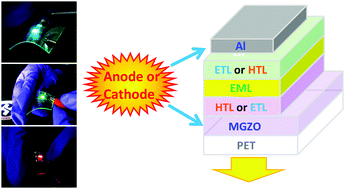Mo-doped GZO films used as anodes or cathodes for highly efficient flexible blue, green and red phosphorescent organic light-emitting diodes†
Abstract
We propose a novel transparent conductive oxide constructed by doping molybdenum into gallium zinc oxide (GZO). The molybdenum doped GZO (MGZO) on a glass substrate possesses a high average transmittance of 92% in the visible wavelength range, a high work function of 5.08 eV, a low sheet resistance of 37.2 Ω sq−1, and an adequate mobility of 2.92 cm2 V−1 s−1. Furthermore, the MGZO films on a PET substrate retained a low electrical sheet resistance after 1000 outward bending cycles. By using MGZO films as anodes in conventional blue, green, and red phosphorescent organic light-emitting diodes (OLEDs) on a PET substrate, low turn-on voltages ranging from 2.7 V to 3.1 V could be obtained. Moreover, the EL efficiencies of the conventional blue, green, and red OLEDs, respectively, reached 21.3%, 17.9%, and 8.9%. In addition, flexible MGZO films were further examined as cathodes in blue (green and red) inverted OLEDs, and gave satisfactory performance including a high efficiency of 16.5% (17.5% and 8.5%) and an acceptable turn-on voltage of 3.6 V (3.1 V and 3.4 V). These superior characteristics make MGZO films high-potential candidates as transparent electrodes for future applications in flexible optoelectronics.


 Please wait while we load your content...
Please wait while we load your content...